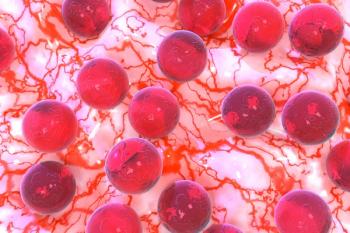
CMG901 Shows Potential in CLDN18.2-Positive Advanced Gastric/GEJ Cancer
CMG901 demonstrated a well-tolerated safety profile in patients with CLDN18.2-positive, advanced gastric/gastroesophageal junction cancer.
Investigators reported that treatment with CMG901 resulted in positive clinical efficacy in a population diagnosed with CLDN18.2-positive, advanced gastric/gastroesophageal junction (GEJ) cancer, according to findings from the phase 1 KYM901 (NCT04805307) study.
In a presentation that was given during an American Society of Clinical Oncology (ASCO) Plenary Session, presenting author Rui-Hua Xu, MD, PhD, reported a confirmed overall response rate (ORR) of 42.0% (95% CI, 24.5%-60.9%) at the 2.2 mg/kg dose level (n = 31), 24.0% (95% CI, 12.1%-39.5%) at the 2.6 mg/kg dose level (n = 42), and 38.0% (95% CI, 15.2%-64.6%) at the 3.0 mg/kg dose level (n = 16). Additionally, the confirmed disease control rate (DCR) in each respective arm was 71.0% (95% CI, 52.0%-85.8%), 67.0% (95% CI, 50.5%-80.4%), and 75.0% (95% CI, 47.6%-92.7%).
Xu is a gastrointestinal medical oncologist, professor of the Department of Medical Oncology, and president of Sun Yat-Sen University Cancer Center, Guangzhou, China.
The confirmed ORR in the total patient population was 33.0% (95%, 23.0-43.3%), and the DCR was 70.0% (95% CI, 59.0%-79.0%). Investigators also reported that 2 additional patients had an ongoing, unconfirmed partial response at the study’s data cutoff of July 24, 2023. Additionally, 1 patient of 19 with CLDN18.2-expressing tumors who didn’t meet the immunohistochemistry threshold of 2+/3+ achieved a confirmed partial response.
In an ORR subgroup analysis, Xu indicated the ORR was consistent across patient subgroups, including those with a poor prognosis such as patients with an ECOG performance status of 1 or peritoneal metastases. Additionally, response was seen regardless of previous lines of therapy, with patients who received 3 or more previous lines of therapy deriving benefit. Responses were also seen regardless of previous taxane or anti–PD-1 agent exposure.
“The data presented today provide a strong rationale to further explore CMG901 as an [antibody-drug conjugate] in CLDN18.2-expressing gastric/GEJ cancer,” Xu said.
To be included on the open-label, multicenter study, patients were required to have a pathologically confirmed advanced solid tumor that was refractory or intolerant to standard treatments. Patients also needed to have an ECOG performance status of 0 or 1. Although CLDN18.2 expression was not required in part A of the study; part B required an expression of 2+ or higher membrane staining intensity in 5% or more of tumor cells.
Part A of the study included several dose levels of KYM901, including 0.3 mg/kg, 0.6 mg/kg, 1.2 mg/kg, 1.8 mg/kg, 2.2 mg/kg, 2.6 mg/kg, 3.0 mg/kg, 3.4 mg/kg, as well as 2.2 mg/kg, 2.6 mg/kg, and 3.0 mg/kg in part B. The study’s primary end points were adverse effects (AEs) and dose-limiting toxicities in part A, and ORR and recommended phase 2 dose in part B.
A total of 113 patients with gastric/GEJ cancer were included in the study who were treated at the 2.2 mg/kg to 3.0 mg/kg dose levels.
Approximately half of all patients were male (52%), and all patients were Asian (100%). Most had an ECOG performance status of 1 (84%), gastric cancer (90%), and a CLDN18.2 expression of 2+ or more membrane staining in 20% or more tumor cells (83%).
The median progression-free survival at the 2.2 mg/kg, 2.6 mg/kg, and 3.0 mg/kg dose levels were 4.8 months (95% CI, 3.6-6.0), 3.3 months (95% CI, 2.2-6.1), and 14.5 months (95% CI, 3.0-not reached [NR]). Additionally, the median overall survival (OS) in each respective arm was NR (95% CI, 6.5-NR), 8.5 months (95% CI, 6.2-NR), and NR (95% CI, 5.2-NR). The 9-month OS rate in at the 2.2 mg/kg, 2.6 mg/kg, and 3.0 mg/kg dose levels were 70.7%, 46.9%, and 56.3%, respectively.
The median duration of response (DOR) was 6.3 months (95% CI, 4.2-NR) in the 2.2 mg/kg cohort with a median follow-up of 5.5 months (95% CI, 4.2-9.0), 5.7 months (95% CI, 2.9-NR) in the 2.6 mg/kg cohort at a median follow-up of 6.0 months (95% CI, 3.8-8.1), and 12.6 months (95% CI, 2.4-NR) at a median follow-up of 7.7 months (95% CI, 5.2-9.7). The median DOR in the overall patient population was 7.2 months (95% CI, 5.3-NR) with a median follow-up of 6.0 months (95% CI, 4.2-8.3).
Drug-related treatment-emergent AEs (TEAEs) occurred in all patients, with grade 3 or higher TEAEs reported in 64% of patients, 54% of which were related to treatment. Serious AEs were reported in 47% of patients, 31% of which were related to treatment. A total of 8% of patients discontinued due to TEAEs.
Common any-grade TEAEs in the overall patient population included anemia (63%), vomiting (58%), hypoalbuminemia (58%), and weight decrease (56%). Grade 3 or higher TEAEs included neutrophil count decrease (19%), anemia (13%), and vomiting (10%).
Reference
Xu RH, Ruan DY, Zhang DS, et al. KYM901 (NCT04805307): a phase 1 trial of claudin 18.2-specific antibody-drug conjugate CMG901 in patients with advanced gastric/gastroesophageal junction cancer. Presented at the American Society of Clinical Oncology Plenary Session. November 7, 2023; virtual; abstract 434420.
Newsletter
Stay up to date on recent advances in the multidisciplinary approach to cancer.


















































































